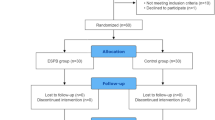Abstract
Background
Erector spinae plane block has been shown to help with pain management in different regions and many areas with different indications. However, the effectiveness of this block in cardiac surgery has been shown in the literature, the optimal volume remains unclear. The aim of this study is to determine the analgesic efficacy of two different volumes of local anesthetic injection used in ultrasound-guided bilateral-thoracic erector spinae plane block in patients undergoing coronary artery bypass graft.
Methods
This study was conducted on adult patients undergoing surgery with coronary artery bypass graft, and 70 patients were analyzed in each group. Group 20 received erector spinae plane block with 20 ml of 0.25% bupivacaine, Group 30 received 30 ml of 0.25% bupivacaine bilaterally. Postoperative sternotomy and chest tube-related pain were evaluated using the numerical rating scale (NRS) at rest and during movement.
Results
There were significant differences between the groups regarding rescue tramadol consumption was higher in Group 20 than in Group 30 (25/35 vs. 2/35, p < 0.001). In addition, there were substantial differences between the two groups concerning the time of the first-rescue analgesic requirement. The mean time ± standard deviation was 11.26 ± 9.57 h and 24.03 ± 4.12 h in Groups 20 and 30 (p < 0.001). The median scores, both at sternotomy and chest tubes, were significantly lower in Group 30 than in Group 20 at the different time points after the surgery (p < 0.05).
Conclusions
In coronary artery bypass graft surgery, erector spinae plane block performed with 30 ml instead of 20 ml on each side resulted in less pain in the sternum and chest tube region, less need for rescue analgesics, and delayed first-rescue analgesic requirement.




Similar content being viewed by others
Data availability
The data underlying this article will be shared on reasonable request to the corresponding author.
References
Zubrzycki M, Liebold A, Skrabal C, Reinelt H, Ziegler M, Perdas E, et al. Assessment and pathophysiology of pain in cardiac surgery. J Pain Res. 2018;11:1599–611. https://doi.org/10.2147/jpr.S162067.
Sharma R, Louie A, Thai CP, Dizdarevic A. Chest wall nerve blocks for cardiothoracic, breast surgery, and rib-related pain. Curr Pain Headache Rep. 2022;26(1):43–56. https://doi.org/10.1007/s11916-022-01001-5.
El Shora HA, El Beleehy AA, Abdelwahab AA, Ali GA, Omran TE, Hassan EA, et al. Bilateral paravertebral block versus thoracic epidural analgesia for pain control post-cardiac surgery: a randomized controlled trial. Thorac Cardiovasc Surg. 2020;68(5):410–6. https://doi.org/10.1055/s-0038-1668496.
Adhikary SD, Prasad A, Soleimani B, Chin KJ. Continuous erector spinae plane block as an effective analgesic option in anticoagulated patients after left ventricular assist device implantation: a case series. J Cardiothorac Vasc Anesth. 2019;33(4):1063–7. https://doi.org/10.1053/j.jvca.2018.04.026.
Noss C, Anderson KJ, Gregory AJ. Erector spinae plane block for open-heart surgery: a potential tool for improved analgesia. J Cardiothorac Vasc Anesth. 2019;33(2):376–7. https://doi.org/10.1053/j.jvca.2018.07.015.
Forero M, Adhikary SD, Lopez H, Tsui C, Chin KJ. The erector spinae plane block: a novel analgesic technique in thoracic neuropathic pain. Reg Anesth Pain Med. 2016;41(5):621–7. https://doi.org/10.1097/aap.0000000000000451.
Ciftci B, Altiparmak B, Tekin B, Sakul BU, Alici HA. Does ESPB performed at the level of T4 cover axillary area? A cadaveric study. J Clin Anesth. 2021;73:110362. https://doi.org/10.1016/j.jclinane.2021.110362.
Athar M, Parveen S, Yadav M, Siddiqui OA, Nasreen F, Ali S, et al. A randomized double-blind controlled trial to assess the efficacy of ultrasound-guided erector spinae plane block in cardiac surgery. J Cardiothorac Vasc Anesth. 2021;35(12):3574–80. https://doi.org/10.1053/j.jvca.2021.03.009.
Tsui BCH, Navaratnam M, Boltz G, Maeda K, Caruso TJ. Bilateral automatized intermittent bolus erector spinae plane analgesic blocks for sternotomy in a cardiac patient who underwent cardiopulmonary bypass: a new era of Cardiac Regional Anesthesia. J Clin Anesth. 2018;48:9–10. https://doi.org/10.1016/j.jclinane.2018.04.005.
Magoon R, Makhija N, Sarkar S. Erector spinae plane block and cardiac surgery: “a closer look.” J Clin Anesth. 2020;60:8. https://doi.org/10.1016/j.jclinane.2019.08.005.
Nagaraja PS, Ragavendran S, Singh NG, Asai O, Bhavya G, Manjunath N, et al. Comparison of continuous thoracic epidural analgesia with bilateral erector spinae plane block for perioperative pain management in cardiac surgery. Ann Card Anaesth. 2018;21(3):323–7. https://doi.org/10.4103/aca.ACA_16_18.
Chin KJ, Adhikary SD, Forero M. Erector spinae plane (ESP) block: a new paradigm in regional anesthesia and analgesia. Curr Anesthesiol Rep. 2019;9(3):271–80. https://doi.org/10.1007/s40140-019-00333-0.
Krishna SN, Chauhan S, Bhoi D, Kaushal B, Hasija S, Sangdup T, et al. Bilateral erector spinae plane block for acute post-surgical pain in adult cardiac surgical patients: a randomized controlled trial. J Cardiothorac Vasc Anesth. 2019;33(2):368–75. https://doi.org/10.1053/j.jvca.2018.05.050.
Taketa Y, Irisawa Y, Fujitani T. Ultrasound-guided erector spinae plane block elicits sensory loss around the lateral, but not the parasternal, portion of the thorax. J Clin Anesth. 2018;47:84–5. https://doi.org/10.1016/j.jclinane.2018.03.023.
Lonnqvist PA, Karmakar MK, Richardson J, Moriggl B. Daring discourse: should the ESP block be renamed RIP II block? Reg Anesth Pain Med. 2021;46(1):57–60. https://doi.org/10.1136/rapm-2020-101822.
Nielsen MV, Moriggl B, Hoermann R, Nielsen TD, Bendtsen TF, Børglum J. Are single-injection erector spinae plane block and multiple-injection costotransverse block equivalent to thoracic paravertebral block? Acta Anaesthesiol Scand. 2019;63(9):1231–8. https://doi.org/10.1111/aas.13424.
Author information
Authors and Affiliations
Corresponding author
Ethics declarations
Conflict of interest
The authors declare that they have no conflict of interest to the publication of this article.
Additional information
Publisher's Note
Springer Nature remains neutral with regard to jurisdictional claims in published maps and institutional affiliations.
Rights and permissions
Springer Nature or its licensor (e.g. a society or other partner) holds exclusive rights to this article under a publishing agreement with the author(s) or other rightsholder(s); author self-archiving of the accepted manuscript version of this article is solely governed by the terms of such publishing agreement and applicable law.
About this article
Cite this article
Demir, Z.A., Aydin, M.E., Balci, E. et al. Ultrasound-guided erector spinae plane block in coronary artery bypass surgery: the role of local anesthetic volume—a prospective, randomized study. Gen Thorac Cardiovasc Surg 72, 1–7 (2024). https://doi.org/10.1007/s11748-023-01953-4
Received:
Accepted:
Published:
Issue Date:
DOI: https://doi.org/10.1007/s11748-023-01953-4




